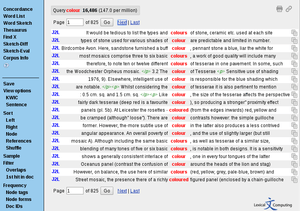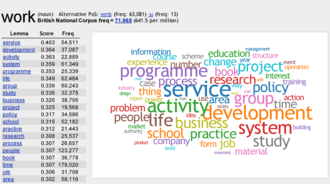Sketch Engine
Sketch Engine is a corpus manager and text analysis software developed by Lexical Computing Limited since 2003. Its purpose is to enable people studying language behaviour (lexicographers, researchers in corpus linguistics, translators or language learners) to search large text collections according to complex and linguistically motivated queries. Sketch Engine gained its name after one of the key features, word sketches: one-page, automatic, corpus-derived summaries of a word's grammatical and collocational behaviour.[2] Currently, it supports and provides corpora in 90+ languages.[3]
 Logo of Sketch Engine | |
 Sketch Engine concordance page | |
| Original author(s) | Adam Kilgarriff, Pavel Rychlý |
|---|---|
| Developer(s) | Lexical Computing Ltd. |
| Initial release | 23 July 2003[1] |
| Written in | C++, Python, JavaScript, jQuery |
| Operating system | Linux, Mac OS X |
| Platform | IA-32, x64 or IA-64 |
| Standard(s) | Unicode |
| Available in | 12 languages |
List of languages English, Czech, Chinese (Traditional, Simplified), Gaeilge, Slovene, Croatian, Arabic, Spanish, French, Ukrainian, Polish | |
| Type | Corpus manager for 90+ languages, database management system |
| License | Proprietary software; both commercial and freeware editions are available |
| Website | www |
History of development
Sketch Engine is a product of Lexical Computing Limited, a company founded in 2003 by the lexicographer and research scientist Adam Kilgarriff.[4] He started collaboration with Pavel Rychlý, a computer scientist working at the Natural Language Processing Centre at Masaryk University[5] and the developer of Manatee and Bonito (two major parts of the software suite), and introduced the concept of word sketches.
Since then, Sketch Engine has been commercial software, however all the core features of Manatee and Bonito that were developed by 2003 (and extended since then) are freely available under the GPL license within the NoSketch Engine suite.[6]
Features
- Word sketches – a one-page automatic derived summary of a word's grammatical and collocational behaviour
- Word sketch difference – compares and contrasts two words by analysing their collocation
- Distributional Thesaurus – automated thesaurus finding words with similar meaning or appearing in the same/similar context
- Concordance search – finds examples of a word form, lemma, phrase, tag or complex structure
- Collocation search – word co-occurrence analysis displaying the most frequent words (to a search word) which can be regarded as collocation candidates
- Word lists – generates frequency lists which can be filtered with complex criteria
- n-grams – generates frequency lists of multi-word expressions
- Terminology / Keyword extraction (both monolingual and bilingual) – automatic extraction key words and multi-word terms from texts (based on frequency count and linguistic criteria)
- Diachronic analysis (Trends)[7] – detecting words which undergo changes in the frequency of use in time (show trending words)
- Corpus building and management – create corpora from the Web or uploaded texts including part-of-speech tagging and lemmatization which can be used as data mining software
- Parallel corpus (bilingual) facilities – looking up translation examples (EUR-Lex corpus, Europarl corpus, OPUS corpus, etc.) or building parallel corpus from own aligned texts
Architecture

Sketch Engine consists of three main components: an underlying database management system called Manatee, a web interface search front-end called Bonito and a web interface for corpus building and management called Corpus Architect. [8]
Manatee
Manatee is a database management system specifically devised for effective indexing of large text corpora. It is based on the idea of inverted indexing (keeping an index of all positions of a given word in the text). It has been used to index text corpora comprising tens of billions of words.[9]
Searching corpora indexed by Manatee is performed by formulating queries in the Corpus Query Language (CQL).[10]
Manatee is written in C++ and offers an API for a number of other programming languages including Python, Java, Perl and Ruby. Recently, it was rewritten into Go for faster processing of corpus queries.[11]
Bonito
Bonito is a web interface for Manatee providing access to corpus search. In the client–server model, Manatee is the server and Bonito plays the client part. It is written in Python.[8]
Corpus Architect
Corpus Architect is a web interface providing corpus building and management features. It is also written in Python.
Applications
Sketch Engine has been used by major British or other publishing houses for producing dictionaries such as Macmillan English Dictionary, Dictionnaires Le Robert, Oxford University Press or Shogakukan and four of the UK's five biggest dictionary publishers use Sketch Engine.[12]
See also
- SkELL – a free web service for students and teachers of English language based on Sketch Engine
- TenTen Corpus Family – a multilingual set of comparable web corpora available through Sketch Engine
References
- Companies House Searched on United Kingdom's registrar of companies (Company name: LEXICAL COMPUTING LIMITED or Company number: 04841901)
- Kilgarriff, Adam; Baisa, Vít; Bušta, Jan; Jakubíček, Miloš; Kovář, Vojtěch; Michelfeit, Jan; Rychlý, Pavel; Suchomel, Vít (10 July 2014). "The Sketch Engine: ten years on". Lexicography. 1 (1): 7–36. doi:10.1007/s40607-014-0009-9. ISSN 2197-4292.
- "Languages in Sketch Engine". Sketch Engine. Lexical Computing s.r.o. Retrieved 22 January 2018.
- Adam Kilgarriff's home page
- Natural Language Processing Centre, Masaryk University
- NoSketch Engine
- Kilgarriff, Adam; Herman, Ondřej; Bušta, Jan; Rychlý, Pavel; Jakubíček, Miloš (2015). "DIACRAN: a framework for diachronic analysis" (PDF). Corpus Linguistics 2015: 65–70.
- Rychlý, Pavel (2007). "Manatee/bonito–a modular corpus manager" (PDF). 1st Workshop on Recent Advances in Slavonic Natural Language Processing: 65–70.
- Pomikálek, Jan; Jakubíček, Miloš; Rychlý, Pavel (2012). "Building a 70 billion word corpus of English from ClueWeb" (PDF). Proceedings of the Eight International Conference on Language Resources and Evaluation (LREC'12).
- "CQL – Corpus Query Language". Sketch Engine. Lexical Computing s.r.o. Retrieved 22 January 2018.
- Rychlý, Pavel; Rábara, Radoslav (2015). "Concurrent Processing of Text Corpus Queries" (PDF). Workshop on Recent Advances in Slavonic Natural Language Processing: 49–58.
- "Using Computational Lexicography for Dictionary Production with the Sketch Engine". REF Impact Case Studies. University of Brighton. Retrieved 18 April 2015.
Further reading
- Thomas, James (March 2016). Discovering English with Sketch Engine : a corpus-based approach to language exploration. Workbook and glossary. Brno: Versatile. ISBN 9788026095798.
External links
| Wikimedia Commons has media related to Sketch Engine. |